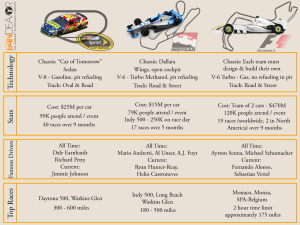If you’re looking to visit one of the world’s premiere racing events, which one should you choose? That’s a common question for those that have just been introduced to the racing world. Hopefully we can help you determine which type of race experience is most suitable for you.
Most everyone has heard of the Indianapolis 500, and everyone hears about the Daytona 500. What about Silverstone, Spa and Monaco? Formula 1 racing is one of Europe’s top sports. It has officially been around since 1950 and brings a constant and consistent stream of followers to every major circuit around the world. You might ask yourself, “What is the difference between the cars, courses, and fans of each major series?” Hopefully we can help you figure this out and spark an interest.

NASCAR
A sport that officially began in 1947, the National Association for Stock Car Auto Racing is based out of Daytona, FL., where it’s headliner race is held twice per year. NASCAR has grown in popularity and is ranked 2nd, behind the NFL, as the highest ranked sport that is televised in the U.S., and holds the top position in sponsorship among Fortune 500 companies. Attendance ranks high, with the Sprint Cup leading the race with around 3.5 million in 2013. Remember, NASCAR holds multiple cup races during a season:
- Sprint Cup (link to https://www.fandeavor.com/nascar-build-your-own)
- Nationwide Cup
- Camping World Truck Series
- ARCA Racing Series
- Canadian Tire Series
- NASCAR Toyota Series
- Whelen Euroseries
- Regional Racing Series
- NASCAR iRacing.com Series
INDY Car Racing
If you haven’t seen an Indy Car, it is noticeably different than the stock cars of NASCAR, having an open wheel design, open cockpit, and wings on the front and rear of the racecar. Inside, it sports a 2.2 liter twin-turbo, methanol powered engine. While drafting is a normal practice, you won’t see much contact here as the threat of a serious accident is much higher with open wheels and carbon fiber shards from the bodywork.
The Indianapolis 500, first raced in 1911, has been known as the Greatest Spectacle in Racing, and takes up the entire month of May with practice, qualifying and the raceday. In the 500-mile race around the 2.5-mile oval, with speeds reaching 230mph, drivers have become legends in the world of racing. Some of those drivers include:
- Mario Andretti
- A.J. Foyt
- Al Unser
- Rick Mears
Al wasn’t the only Unser to win at Indy; his brother Bobby won 3 times and his son, Al Jr., won twice, bringing the total to 9 wins for the Unser family.
The Long Beach Grand Prix, raced on the streets, is another well-known Indy Car race that brings excitement because of a high celebrity turnout, and their own celebrity race. Indy Car races happen on oval, temporary street, and dedicated road courses, of which Watkins Glen is one of the most famous, hosting races for many different series.
Formula 1
F1 racing is the pinnacle of all auto racing in terms of technology, budget, and glamour. Only 11 teams are authorized to compete in the 17 event series with races all over the globe. This makes for an extremely competitive environment, in which teams spend upwards of $470M per year for their 2-car team. Some of the prerequisites for entering a team into the F1 series are:
- Designing and constructing their own unique and advanced racecars within specifications for the chassis and power plant, like having a 1.6-liter turbo-charged gasoline powered engine.
- Each of the 11 teams is a franchise which means that no new teams can enter until another is sold, and each must prove that they can compete at the same level as the other teams
This sport attracts some of the world’s most passionate fans, sometimes climbing trees to view the course (getting the best seat in the house). These fans root for teams instead of the face of the franchise, which are the drivers in other series. Ferrari, Red Bull, and Mercedes are some of the fan’s favorite teams. If you’re Italian, you’re a Ferrari fan, period. (Se sei Italiano, tifa Ferrari, basta!)
The attention to detail doesn’t lack when it comes to the rest of the race, either. The tracks, the garages, and even the team trailers are extravagant, mirroring the image of the sport: invigorating, high-end and sexy. Pit stops can be exciting to watch for the 2.4 seconds that they last, compared to the 10+ seconds for Indy Cars, and 15 seconds for NASCAR. Even more exciting are the standing starts where the drivers wait for a green light before racing to the first turn. It might not seem the logical place for “green” technology, but the ERS (energy recovery system) in the F1 power plant allows the smaller engine with a single turbo to take energy from the intense braking in the corners, and transfer it to the battery for straight line acceleration thus allowing for an engine with less horsepower to recycle and reuse the car’s own kinetic energy.
In decades past, F1 car designers looked to the aerospace industry for inspiration and technology. But F1 technology develops at such a fast pace, that these days, the aerospace industry turns to F1 when it comes to concepts, systems and design.
Luckily, the F1 series visits North America twice per year, in Montreal in June, and Austin, Texas in November. Don’t miss this chance to see world class racing in its highest form when they come to town!
If you’re interested in attending one of these amazing Formula 1 races, check out our Fandeavor F1 page (Click here)
And for NASCAR, check out the Fandeavor NASCAR page (Click here)
